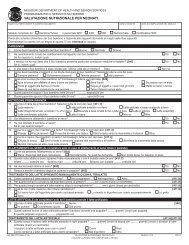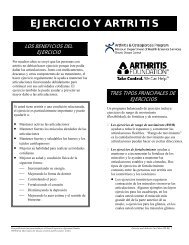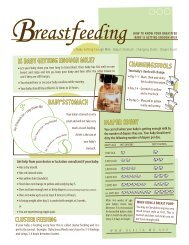Prevention and Control of Communicable Diseases - Missouri ...
Prevention and Control of Communicable Diseases - Missouri ...
Prevention and Control of Communicable Diseases - Missouri ...
You also want an ePaper? Increase the reach of your titles
YUMPU automatically turns print PDFs into web optimized ePapers that Google loves.
Your child may have been exposed to:<br />
July 2011<br />
Scabies<br />
If you think your child<br />
has Scabies:<br />
� Tell your childcare<br />
provider or call the<br />
school.<br />
� Need to stay home?<br />
Childcare <strong>and</strong> School:<br />
Yes, until after treatment<br />
has been completed.<br />
193<br />
PARENT/GUARDIAN<br />
Scabies is caused by tiny mites that live under the<br />
skin. Check your child for a rash.<br />
Symptoms<br />
Your child may itch the most at night. Look for a rash <strong>of</strong><br />
pink bumps or tiny blisters. Sometimes, you can only<br />
see scratch marks. Common locations for the rash <strong>and</strong><br />
itching are between fingers, around wrists <strong>and</strong> elbows,<br />
<strong>and</strong> armpits. Infants <strong>and</strong> young children may be infested<br />
on head, neck, palms, <strong>and</strong> bottoms <strong>of</strong> feet.<br />
People without previous exposure may develop<br />
symptoms in 2 to 6 weeks. People who were previously<br />
infested are sensitized <strong>and</strong> may develop symptoms in 1<br />
to 4 days.<br />
Spread<br />
- By having repeated direct contact with the skin <strong>of</strong> a<br />
person with scabies.<br />
- By sharing bedding, towels, or clothing that was used<br />
by a person with scabies.<br />
The mites cannot live <strong>of</strong>f the human body for more than<br />
3 days. They cannot reproduce <strong>of</strong>f the body or on<br />
pets.<br />
Contagious Period<br />
From when a child gets the mites until 24 hours after<br />
treatment begins. A child is contagious before the rash.<br />
Call your Healthcare Provider<br />
♦ If anyone in your home has symptoms. Your doctor<br />
may do a test <strong>and</strong>/or give a medication, usually a<br />
cream or lotion.<br />
♦ Even with treatment, it <strong>of</strong>ten takes 2 to 3 weeks for<br />
rash <strong>and</strong> itching to go away. Ask your doctor who in<br />
the household needs to be treated.<br />
<strong>Prevention</strong><br />
� At time <strong>of</strong> treatment, wash items used in the past 48 hours in hot water <strong>and</strong> put them<br />
in a hot dryer. Examples <strong>of</strong> things to wash are underwear, pajamas, bedding, <strong>and</strong><br />
towels. Items that cannot be washed should be sealed in a plastic bag for one week.<br />
� Vacuum upholstered furniture <strong>and</strong> carpeting. DO NOT use insecticide sprays.<br />
For more information, call <strong>Missouri</strong> Department <strong>of</strong> Health <strong>and</strong> Senior Services (MDHSS) at<br />
573-751-6113 or 866-628-9891 (8-5 Monday thru Friday) or call your local health department.
















